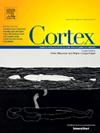The effect of stimulus type and tempo on sensorimotor synchronization during finger-tapping in cerebellar ataxia: Behavioral and neural evidence
IF 3.3
2区 心理学
Q1 BEHAVIORAL SCIENCES
引用次数: 0
Abstract
Sensorimotor synchronization, coordination of movements with external rhythms, occurs daily. Finger-tapping tasks are often used to study biological mechanisms underlying sensorimotor synchronization. This study investigates how deviations in auditory stimulus tempo from spontaneous motor tempo affect sensorimotor synchronization in patients with cerebellar ataxia during active listening and finger-tapping. Specifically, the cerebellum's role in these tasks is investigated by quantifying behavioral and neural dynamics of auditory-motor coupling. Sixteen patients with cerebellar ataxia and 14 healthy controls listened and tapped to music and metronomes at seven tempi (−12%, −8%, −4%, 0%, +4%, +8%, +12% of spontaneous tapping tempo) in randomized order. Sixty-four channel EEG, stimulus beat- and finger-tapping onsets were recorded during each trial. Behavioral synchronization was quantified by synchronization precision and accuracy, whereas neural entrainment was quantified with the stability index. Cerebellar patients displayed higher, more variable spontaneous tapping tempi than controls. Although precision was lower in patients than controls, they achieved high precision values. Differences in synchronizing between metronomes and music were observed for both precision and accuracy, favoring metronomes in both groups. Accuracy was impacted, with lowest asynchrony observed in patients with music, and across groups at the slowest tempi (−12%) and highest tempi (4, 8 and 10%). EEG results revealed greater stability for music during tapping. Although patients with cerebellar ataxia showed synchronization deficits, they could sufficiently synchronize with isochronous metronomes and music containing higher complexity, likely through sensory accumulation as a compensation strategy. These findings support the use of sensorimotor synchronization strategies in rehabilitation for cerebellar disorders.
刺激类型和节奏对小脑共济失调手指敲击过程中感觉运动同步的影响:行为和神经证据
感觉运动同步,即运动与外部节奏的协调,每天都在发生。手指敲击任务经常被用来研究感觉运动同步的生物学机制。本研究探讨了小脑共济失调患者在主动聆听和手指敲击时,听觉刺激节奏与自发运动节奏的偏差对感觉运动同步的影响。具体来说,小脑在这些任务中的作用是通过量化听觉-运动耦合的行为和神经动力学来研究的。16例小脑性共济失调患者和14例健康对照者按随机顺序按7个节拍(自发节拍的- 12%、- 8%、- 4%、0%、+4%、+8%、+12%)听音乐和节拍器。在每次试验中记录64通道脑电图、刺激搏动和手指敲击发作。以同步精度和准确度量化行为同步,以稳定性指标量化神经夹带。小脑患者表现出比对照组更高、更多变的自发叩击节奏。虽然患者的精度低于对照组,但他们达到了很高的精度值。在节拍器和音乐之间的同步的精度和准确性的差异被观察到,有利于节拍器在两组。准确性受到影响,在播放音乐的患者中观察到的非同步性最低,在最慢的节奏(- 12%)和最高的节奏(4,8和10%)组中观察到的非同步性最低。脑电图结果显示,敲击时音乐的稳定性更强。尽管小脑性共济失调患者表现出同步缺陷,但他们可以充分地与等时节拍器和包含更高复杂性的音乐同步,可能是通过感觉积累作为一种补偿策略。这些发现支持感觉运动同步策略在小脑疾病康复中的应用。
本文章由计算机程序翻译,如有差异,请以英文原文为准。
求助全文
约1分钟内获得全文
求助全文
来源期刊

Cortex
医学-行为科学
CiteScore
7.00
自引率
5.60%
发文量
250
审稿时长
74 days
期刊介绍:
CORTEX is an international journal devoted to the study of cognition and of the relationship between the nervous system and mental processes, particularly as these are reflected in the behaviour of patients with acquired brain lesions, normal volunteers, children with typical and atypical development, and in the activation of brain regions and systems as recorded by functional neuroimaging techniques. It was founded in 1964 by Ennio De Renzi.
 求助内容:
求助内容: 应助结果提醒方式:
应助结果提醒方式:


